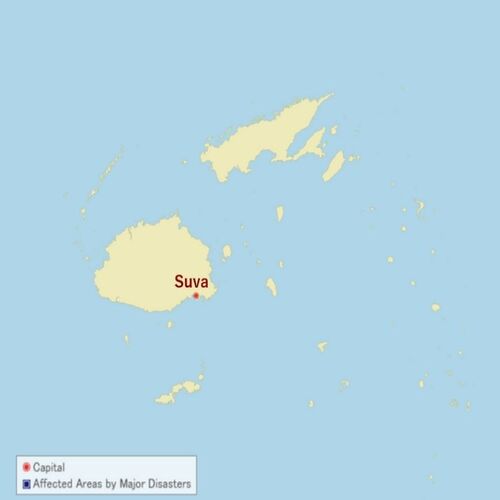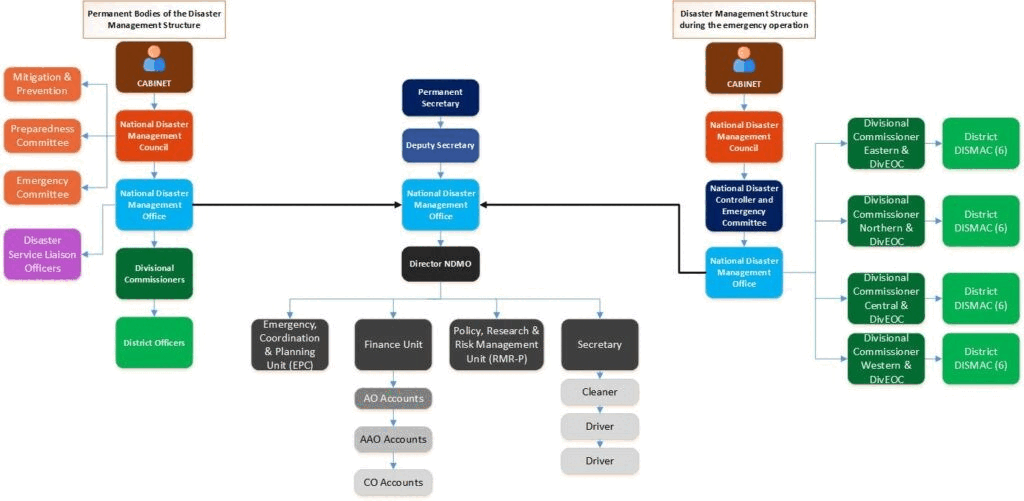TOP PAGE > Information on Disaster Risk Reduction of the Member Countries
Information on Disaster Risk Reduction of the Member Countries
 Fiji
Fiji
General Information
 Formal Name: Republic of Fiji
Formal Name: Republic of FijiFiji is an island country located in the South Pacific Ocean, consisting of more than 330 islands, of which about 110 are inhabited. The two major islands, Viti Levu and Vanua Levu account for 87% of the population. The country covers a total area of 18,274 square kilometers, with a coastline of 1,129 kilometers. Suva located on the island of Viti Levu, is the capital and largest city. According to the 2017 census, the population of Fiji is approximately 884,887 (Fiji Bureau of Statistics, 2017).
Overview of Disasters
Given its location in the tropical cyclone belt and the Pacific Ring of Fire, Fiji is highly vulnerable to natural disasters. The country experiences frequent tropical cyclone floods, landslides, and storm surges. Climate change has intensified these challenges, resulting in rising sea levels, coastal erosion, and more severe tropical cyclones.
Recent Major Disasters
Tropical Cyclone Yasa (December 2020)
Tropical Cyclone Yasa was a Category 5 storm that made landfall on the northern island of Vanua Levu on 17 December 2020, causing widespread devastation. The cyclone brought winds of up to 240 km/h, heavy rainfall, and storm surges. According to the National Disaster Risk Management Office (formerly National Disaster Management Office), four people lost their lives, and thousands were displaced. The cyclone caused an estimated FJD 500 million in damages (Government of Fiji, 2021).
Tropical Cyclone Winston (February 2016)
Tropical Cyclone Winston was the strongest tropical cyclone ever recorded in the Southern Hemisphere. It made landfall on 20 February 2016, with wind speeds reaching 306km/h, causing significant destruction across Fiji. Over 44 people lost their lives, and 40,000 homes were damaged or destroyed. The estimated total economic loss was around FJD 2 billion (World Bank, 2016).
Flood (January 2012)
In January 2012, heavy rainfall caused severed flooding in the western and northern parts of Viti Levu, Fiji’s main island. The floods affected over 13,000 people, displaced 8,000, and caused 11 fatalities. The economic impact was significant, with damage to infrastructure, agriculture, and housing estimated at FJD 200 million (approximately USD 100 million) (Fiji National Disaster Management Office, 2012).
Disaster Management System
Legal System
Fiji’s disaster risk management framework is governed by the National Disaster Risk Management Act 2024 (NDRM 2024), which repeals the previous Natural Disaster Management Act 1998. The new Act established a legal framework for disaster risk governance, disaster risk reduction, disaster risk management, and disaster management. The Act emphasizes a shift from a reactive post-disaster response approach to a proactive, risk-focused disaster management system.
Organization
 Fiji’s disaster risk management framework is governed by the National Disaster Risk Management Act 2024, which replaces the previous Natural Disaster Management Act 1998. The new Act established a comprehensive legal framework for disaster risk governance, emphasizing a proactive, risk-focused approach. Key institutions include the National Disaster Risk Management Council (NDRMC), responsible for policy approval and oversight, and the National Disaster Risk Management Office (NDRMO), which handles day-to-day operations, training, and coordination. The Act also established the Disaster Rısk Reduction Committee and the Emergency Committee to focus on risk reduction and emergency response, respectively.
Fiji’s disaster risk management framework is governed by the National Disaster Risk Management Act 2024, which replaces the previous Natural Disaster Management Act 1998. The new Act established a comprehensive legal framework for disaster risk governance, emphasizing a proactive, risk-focused approach. Key institutions include the National Disaster Risk Management Council (NDRMC), responsible for policy approval and oversight, and the National Disaster Risk Management Office (NDRMO), which handles day-to-day operations, training, and coordination. The Act also established the Disaster Rısk Reduction Committee and the Emergency Committee to focus on risk reduction and emergency response, respectively. Plan
The Fiji National Disaster Management Plan provides a framework for disaster risk management, focusing on preparedness, response, recovery, and mitigation. The plan emphasizes community-based disaster risk management, focusing on preparedness, response, recovery, and mitigation. The plan emphasizes community-based disaster risk management, recognizing the importance of local knowledge and participation in reducing disaster risks.
Mission
To enhance the resilience of Fiji’s communities to disasters through effective risk management, preparedness, and response.
Vision
To create a disaster-resilient Fiji where communities are safe, sustainable, and capable of recovering quickly from disasters.
Objectives
Objective 1: To strengthen disaster risk reduction and preparedness at all levels of society
Objective 2: To ensure effective and coordinated disaster response and recovery
Objective 3: To integrate climate change adaptation into disaster risk management
Objective 4: To enhance regional and international cooperation in disaster risk management
Mission
To enhance the resilience of Fiji’s communities to disasters through effective risk management, preparedness, and response.
Vision
To create a disaster-resilient Fiji where communities are safe, sustainable, and capable of recovering quickly from disasters.
Objectives
Objective 1: To strengthen disaster risk reduction and preparedness at all levels of society
Objective 2: To ensure effective and coordinated disaster response and recovery
Objective 3: To integrate climate change adaptation into disaster risk management
Objective 4: To enhance regional and international cooperation in disaster risk management
ADRC Counterpart
Disaster Information (The latest 10)
・2020/12/17 : Tropical Cyclone
・2020/04/08 : Tropical Cyclone
・2018/03/31 : Tropical Cyclone
・2016/02/20 : Tropical Cyclone
・2012/03/30 : Tropical Cyclone

